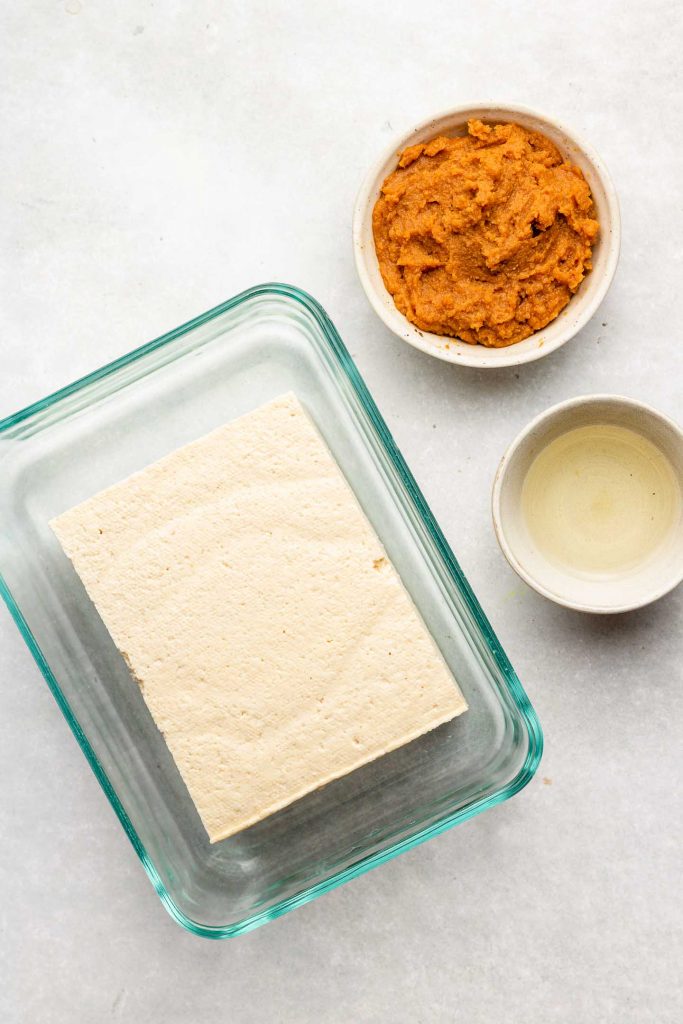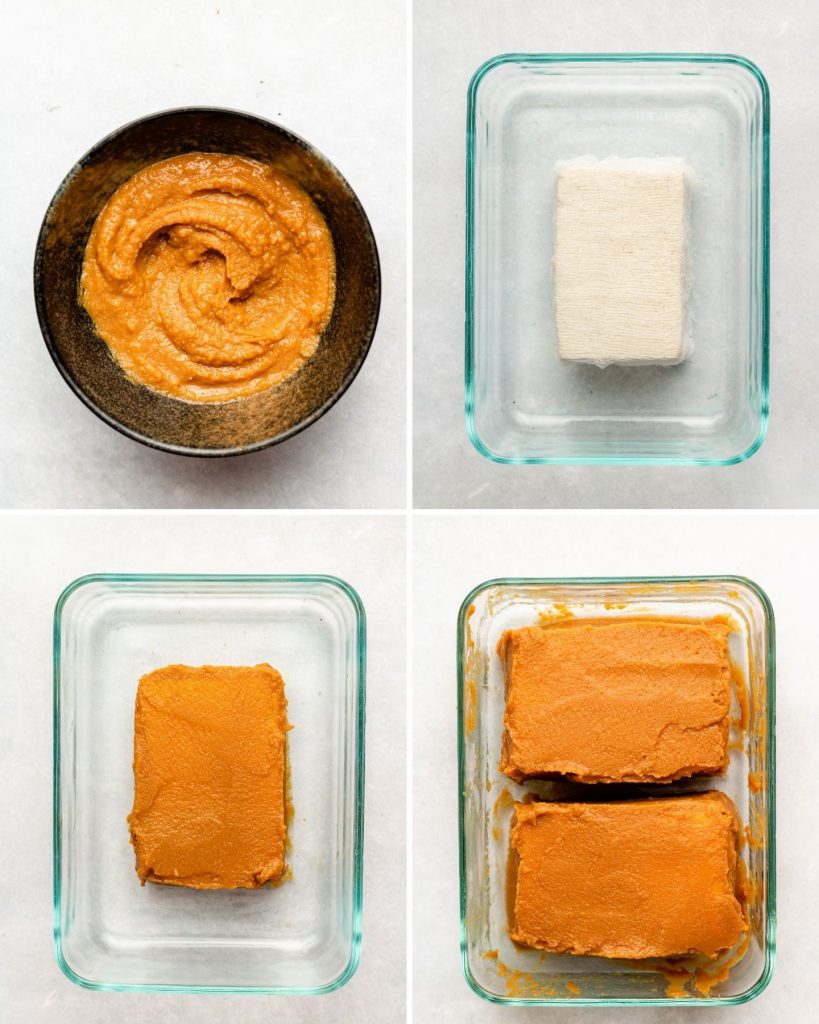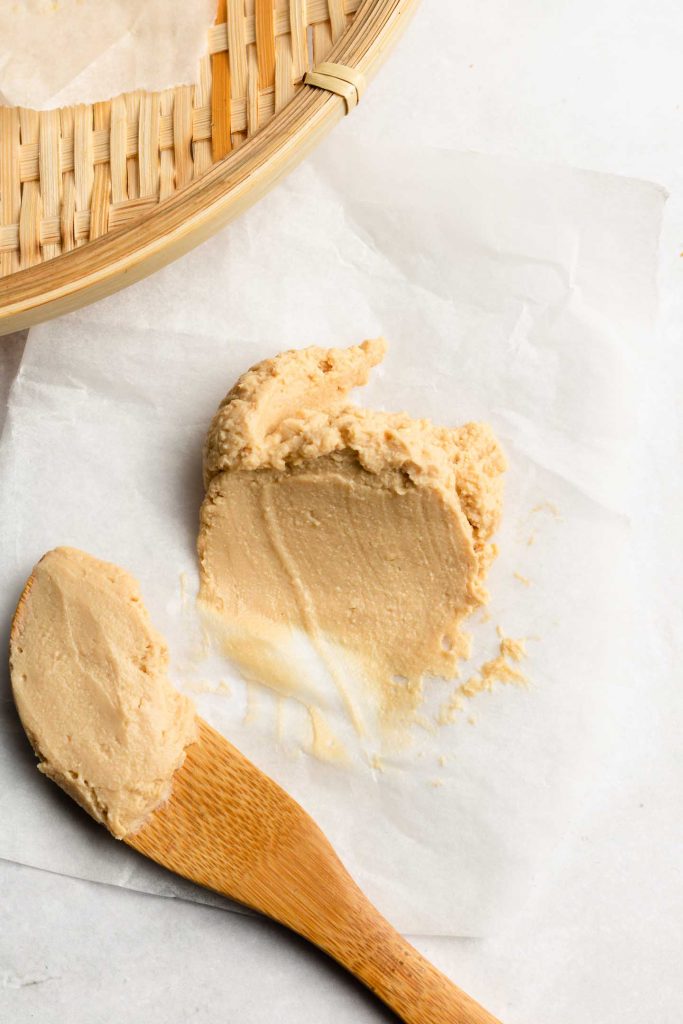
Learn how to make Misozuke (Miso Tofu Fermented Cheese) right in your own kitchen with this easy step-by-step guide!

Have you heard of misozuke? This cheese-like delicacy is originated in Fukuoka— which is where I first had the pleasure of trying it. It’s rich, umami, creamy, salty and tangy flavour is reminiscent of cream cheese & feta.
2 years ago when I visited Japan, I was talking to my uncle about this amazing tofu cream (that I constantly shared on instagram)– and I found out my uncle LOVES this stuff and has gotten to know the seller he purchases it from. He was kind enough to share essentially how you can make this ‘cheese’ at home with just a few simple ingredients. The past year, I’ve been experimenting with misozuke and I’m so excited to finally share this special dish today!
What is misozuke?
Essentially, it is tofu fermented with miso wrapped around it. It can be found either in ‘pickled’ form or ‘cream-cheese’ like texture– depending on where you purchase or try it.
How does miso paste turn tofu into something like cheese?! Keep reading to find out 🙂

How to Make Misozuke
The Ingredients
- Firm OR Extra Firm Tofu: I’ve tried making misozuke with both firm and extra firm tofu. Both work but the consistency will vary (depending on the brand as well). Extra firm tofu will yield a thicker, richer cheese (slightly more crumbly when cutting into it but still super creamy).
- Miso Paste: White or red smooth miso paste can be used. Red miso paste makes it slightly more saltier.
- Sake (optional): Can be omitted but does add to the cheese-like flavour.
- Sugar (optional): Balances out the saltiness and tanginess of the cheese.
- Herbs, spices & other flavourings (optional): See below for recommendations! Be sure to use organic zests and dried herbs if using.
Equipment
You don’t need any special equipment to make misozuke, just an air tight sterile container and cheesecloth.

The directions
- Mix the miso paste, sake, sugar and optional flavourings in a bowl until well combined.
- Remove the tofu from the package. Gently press out any excess liquid and pat it dry. (You can press out excess liquid if you are using firm for a richer consistency). Cut the tofu into two blocks. Wrap one or two layers of cheesecloth over each piece of tofu. Using only one layer will make the misozuke more salty. Spread a generous layer of miso paste on top of the cheesecloth. Be sure every part is covered so that no cheesecloth or tofu is exposed.
- Place in an air tight container and store in the fridge for 7 – 100 days, depending on how long you want to ferment it. Optionally, you can place a layer of paper towel into the Tupperware to remove the accumulated liquid easier.
- Every week, check the misozuke. If you see any liquid accumulating, carefully pour it out. Ensure that the block of tofu is still fully covered with miso and that the container is fry. If you accidentally scrape off some miso, cover it with more miso.
- After the fermentation period is over, unwrap the tofu and remove any remaining miso paste. Now it’s ready to serve!
Fermentation Period: How long should you ferment tofu cheese?
There are two types of tofu misozuke you can find in Japan:
- ‘Pickled’ Misozuke (short term <1 week): This is more so enjoyed as a snack or side dish. Typically eaten sliced or cubes alongside crackers or beer.
- Cured/Fermented Misozuke (long term 2+ months): Enjoyed as a spread like cream cheese or fancy cheeses like Brie. In Japan, some places ferment their miso tofu for up to two years!
These are some of the time frames I’ve experimented with that yield different texture and flavours:
- 1 week (7 days): Slightly creamier but still the texture of tofu. Not spread-able but can be eaten as a side dish/snack.
- 1 month (30 days): Spreadable but crumbly. A salty flavour has developed throughout the tofu.
- 2 months (60 days): Spreadable and creamy. Flavour has developed throughout the tofu and has some tanginess to it.
- 3 months (90 days): Very spreadable, rich and creamy. The flavour has intensified, gotten much saltier, tangier and has more umami.
- 110 days: Not much different than 3 months.
Summary: I found the best fermentation time to achieve that super rich, cream-cheese like texture to be anywhere from 90-100 days. However, if you want something like a block cheese (for snacking or crackers), you can get away with fermenting for a shorter period of time. Try different fermentation times to see which one you like best!
Troubleshooting & Mold
Be sure to monitor the misozuke at least once a week, ensuring the container is dry. If you see any liquid accumulating, pour it out. The container should be kept dry (you can layer some paper towel down to make this process easier).
I’ve never had a problem with growing lots of mold. Little spots of mold can be removed and replaced with fresh miso paste, but it is best to prevent any mold development.
Please use your best judgement when evaluating your misozuke as fermenting of any kind carries risks. When in doubt, toss it.

Tofu Cheese Flavour Variations
Once you’ve tried misozuke, I highly recommend trying out different flavours and variations! Here are a couple I’ve tried and loved (with flavour descriptions):
- Plain: Very creamy, salty but the most mild in flavour. Tangy, rich and easily spreadable. Reminiscent of cream cheese and feta.
- Lemon Zest: Slightly thicker, more tangy. Reminiscent of a rich cheesecake and feta.
- Yuzu Salt: Tangier and saltier. Texture similar to lemon zest.
- Umeboshi: Saltier and more umami. Slightly thicker in texture than the plain.
- Red pepper flakes: The thickest, creamiest and richest out of them all with a very subtle spiciness. Reminiscent of Brie or Camembert.
- Nori: Slightly more crumbly (but still creamy). Lots of umami flavour, slightly tangier and most similar to Wensleydale and Roquefort.
- Other (dried) herbs & spices: You can also add other herbs and spices for flavour! It will be very mild but I think garlic herb or dill would be delicious

Ways to serve misozuke
Misozuke can be served any way you would cheese! Here are some of my personal favourite ways and suggestions:
- cut into cubes (for pickled misozuke) or smear on crackers
- pair with beer, sake and wine!
- serve with vegetables or add to salads
- add it to dressings and sauces
- use it so pasta and casseroles (it bakes well!)
- spread it over pitas and pizza
- use it in sandwiches, wraps, bagels and toast
More Vegan Cheese Recipes to Try!
If you recreate this Misozuke recipe let me know how you liked it by leaving a comment and rating below or by tagging me on Instagram @Okonomikitchen, I love seeing all of your tasty recreations!
Hungry for more? Be sure to subscribe to my newsletter and follow along on Instagram, Youtube and Pinterest for more deliciousness!

Misozuke (Miso Tofu Cheese)
- Total Time: 10 minutes
- Yield: 14 servings 1x
Ingredients
Misozuke
- 1 lbs package of firm or extra firm tofu (454g)
- 200–250g organic white or red miso paste
- 2 tbsp sake (30ml)
- 2 tbsp organic cane sugar (28g)
Flavourings (optional)
- dried herbs
- dried spices
- zests of citrus fruits
- yuzu salt
- umeboshi
- chili flakes
- nori
Instructions
- Mix the miso paste, sake, sugar and optional flavourings in a bowl until well combined.
- Remove the tofu from the package. Gently press out any excess liquid and pat it dry. Cut the tofu into two blocks. Wrap one layer of cheesecloth over each piece of tofu. Spread a generous layer of miso paste on top of the cheesecloth. Be sure every part is covered so that no cheesecloth or tofu is exposed. Place in an air tight container and store in the fridge for 7 – 100 days (read blog post for fermentation times). **
- Every week, check the misozuke. If you see any liquid accumulating, carefully pour it out. Ensure that the block of tofu is still fully covered with miso and that the container is fry. If you accidentally scrape off some miso, cover it with more miso.
- After the fermentation period is over, unwrap the tofu and remove any remaining miso paste.
- Serve as desired and enjoy! To store, wrap with vegan wax paper and keep in an air tight container for up to 1 week.
Notes
- ** If you are diligent with monitoring your misozuke, there shouldn’t be a problem with mold growing. You can also layer paper towel into the container first for easier removal of the accumulated liquid (I just didn’t find it necessary as long as you drain it every couple of days and I don’t want to waste paper towels).
- Helpful Equipment: cheesecloth, air tight container, offset spatula, spatula, mixing bowls, whisk
- Nutritional Information Disclaimer: Nutrition information is a rough estimate calculated on an online tool (Cronometer).
- Prep Time: 10 minutes
- Category: appetizer
- Method: fermenting
- Cuisine: vegan, gluten free, japanese
Nutrition
- Serving Size: 2 tbsp
- Calories: 33
- Sugar: 0.8
- Sodium: 106mg
- Fat: 1.7
- Saturated Fat: 0.3
- Unsaturated Fat: 1.1
- Trans Fat: 0
- Carbohydrates: 1.4
- Fiber: 0.3
- Protein: 3.6
- Cholesterol: 0
SAVE IT FOR LATER! ↓
Okonomi Kitchen is a participant in the Amazon Services LLC Associates Program. When you purchase something through my amazon affiliate links, I earn a small commission that helps me produce consistent content at no cost to you. Thank you for supporting my plant based kitchen!











I made this about 2-3 weeks ago and there is mold on the outside of it. Any ideas what I could have done wrong? The tofu is completely covered in the paste.
Usually it’s the intoduction of bacteria, so perhaps something wasn’t cleaned thoroughly! You can scrape that part off, removing all of the mold and then cover if it’s small spots!
I absolute love this “cheese”! I first saw how to make it in “The Now and Zen Epicure” by Miyoko Schinner, back when we were completely vegan, about 20 years ago. We let it age for 2 months, and it was absolutely delicious. If I were to do it again, I’d start a new batch every two weeks or so, so that we would have an ongoing supply. If I remember correctly, though, we did not refrigerate it, just stored it in a dark cupboard and checked it every week.
Actually, her recipe says to refrigerate it, so I must have done that. But I did let it age for quite awhile and it was pretty amazing!
Hi, thanks for this thorough guide!
I wonder – can I make misozuke with shio koji, instead of miso?
Since the enzymes in miso come from koji in the first place, I think this should be an option – or does the slurry require alcohol to ward of contaminant microbes?
So good, I make it every 3 weeks, to be sure to always have some! Although I’m living in Japan for 6 years now I didn’t know “misozuke tofu” and my husband never had the chance to eat some so I was thrilled by the idea!
It’s a little tricky to cover all the tofu and my kitchen turn into chaos every time, but it’s worth it! I tried “nori”, “plain” and “ume-shiso”, which is my favorite, but I’m planning on making some with black sesame miso.
Hi! If I were to add nori, how would I mix it in?
OMG! There is a black sesame miso?? Do you know where I can buy in in Europe?
I just unwrapped my misozuke and I’m beyond amazed. Super easy and tastes really cheesy and tangy and the texture is unreal.
OMG, it has a name!!! Years ago I was marinating tofu cubes in a sauce made of thinned miso and herbs, and somehow the container got shoved to the back and forgotten for a week or two. When I discovered it, the cubes had turned soft and creamy, and smelled very appetizing, so I tasted it.. and was impressed! I eventually used it all…and didn’t die, lol… so the next time I wanted a creamy vegan spread, I tried to repeat the same thing… cubed the tofu, put it in a container, poured over some thinned miso and herbs, covered it and let it sit in the fridge for a week. Success! Since the result I wanted was a creamy spread, and since tofu is so bland, I eventually tried tossing a block of tofu in the blender with enough miso and herbs/spices to season it, put it in a covered container, and stuck it in the fridge for just a few days. It was amazing… and far quicker! Now this gets really out there… but last time I tried blending in some natto for more cheesy “funk”, and it reminded me of an already melted creamy brie/ camembert!!! I’m hooked!
Your experiments sound interesting. Do have some recipes or advice how to try?
Well worth waiting 3 months. Tasted like laughing cow cheese wheels, v addicting. I did have issues with mold but I removed it and added more miso paste as suggested. I did not keep a paper towel underneath to absorb the moisture which I think may account for the mold growth. I’m going for another batch with the paper towel this time. Will report on the difference!
This one was even better than advertised. I opened one at 75 days with added mushroom dashi and togarashi and it was so tasty! I didn’t have cheesecloth so spreading the mixture directly on the tofu was messy but worked out well. Also developed a spot of mold but easily removed and covered and no problem afterwards. Lookin forward to the 90 day one I still have goin!
After about 2 months of waiting my misozuke is finally ready! I used white miso and I think extra firm tofu (it’s been a while!) and it came out creamy and spreadable, maybe a tiny bit crumbly but I was easily able to spread it on crackers. I just wolfed down 1/4 of what I made (a full block of tofu) and am scheming to make more to have a rotation of different variations in the fridge at all times.
Thanks for such a great recipe! I fermented two weeks with a semi-red miso and used “shima-dofu” which is as firm as it comes in Japan. The outer part of the tofu was dark and creamy and uber rich and salty, the inside lighter and less rich but still super tasty. This recipe is a solid five stars, hands down…if you can wait 😉